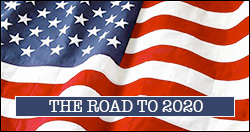By Jim Ellis
 Feb. 6, 2019 — The Emerson College Polling Institute and Monmouth University just released two presidential polls, the former of Iowa voters, the latter, a national study.
Feb. 6, 2019 — The Emerson College Polling Institute and Monmouth University just released two presidential polls, the former of Iowa voters, the latter, a national study.
The Emerson poll (Jan. 30-Feb. 2; 831 registered Iowa voters, 260 likely Iowa Democratic caucus attenders) finds former Vice President Joe Biden leading Sens. Kamala Harris (D-CA) and Bernie Sanders (I-D/VT), 29-18-15 percent, while Sen. Elizabeth Warren (D-MA) posts 11% support.
The other candidates land in single digits: ex-Rep. Beto O’Rourke (D-TX) at six percent; Sens. Cory Booker (D-NJ) and Sherrod Brown (D-OH) both with four percent; Sen. Amy Klobuchar (D-MN) has three percent; while former HUD Secretary Julian Castro posts two percent, and ex-Rep. John Delaney (D-MD) each register one percent support.
The results are consistent with previous polls conducted of the Iowa Caucus sampling universe even though the Democratic sample in this survey is very low.
During the period of Jan. 25-27, Monmouth University tested a national sample of 735 registered US voters from a pool of 805 adults to determine perceptions mostly of the Democratic candidates, but also queried the aggregate respondent universe about President Trump.
Interestingly, the Monmouth ballot test segmented very closely to what Emerson produced in Iowa. Nationally, Biden posts 29 percent support, the same preference number that Emerson found in Iowa. The national poll, however, reverses second and third positions from the Hawkeye State listing. Here, Monmouth finds Sen. Sanders in second place with 16 percent, followed by Harris’ 11 percent. Sen. Warren drops to eight percent on the national scale, and ex-Rep. O’Rourke records seven percent support.
Yet, from the Monmouth poll, in another similarity to the Iowa Emerson findings, the Democratic cell segment is simply too small – 313 from the Monmouth sample – to accurately depict how the Democratic candidates stand from a national perspective. Even so, the fact that the candidate standing and polling divide was numerically very similar in the two polls, one of the country as a whole and the other for the first key voting state, is of some significance.
Although neither Sen. Ted Cruz (R-TX) nor ex-Ohio Gov. John Kasich are giving any indication that they would challenge President Trump for the Republican nomination, Monmouth tested such potential pairings. Overall, among the tested Republicans, 49 percent say they want to see Trump run unopposed for re-nomination, but 43 percent would prefer him to face primary opposition.
If Sen. Cruz were to challenge the president,Trump would lead the battle for the GOP nomination by a 66-21 percent count. If Kasich were the candidate, the split favors the president by an even greater 72-14 percent. Like in their Democratic segmentation, the Monmouth Republican voter split is woefully low for a national survey, 335 respondents, so the error factor for these Democratic and Republican sample cell responses is very high.
Emerson looked at Iowa pairings for President Trump against the Democrats in hypothetical general election duels. The Hawkeye State, with its six electoral votes, is a critical national swing state. Individually against the tested seven Democratic candidates, President Trump fares well before the entire 831-person Iowa respondent sample.
In fact, Trump would only trail ex-VP Biden, if the election were during the sampling period, by a small 51-49 percent margin.
Against the others, the president would carry Iowa: 51-49 percent over Sen. Sanders, 52-48 percent opposite Sen. Warren, and 53-47 percent versus Sen. Harris. He would defeat O’Rourke, 53-47 percent, top Sen. Gillibrand 54-46 percent, and Ohio Sen. Brown, 55-45 percent.
Though such early polling is virtually meaningless for an Iowa Caucus now just a year away and a general vote all the way to November 2020, the polls do give us an indication of where the president stands before the tested samples at the end of January. As other polls also show, this is a particularly negative period for Trump in terms of public perception.
